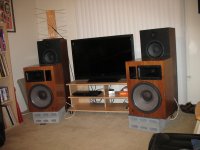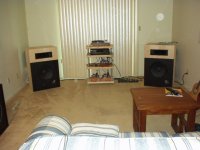Re: Sound quality of "PI" speakers?
PI speakers are the same off-the-shelf Eminence PA crossover (3rd order high pass, 2nd order low pass) applied to various combinations of drivers. No-one has ever seen a measurement of a PI horn speaker to know if by chance they happen to sum flat--not even the guy selling them knows as he doesn't measure his speakers. I am willing to bet large sums of money that they don't sum flat. The reason is that the acoustic center of the horn tweeters are located well behind the acoustic center of the woofer. In this case, it is standard practice to use a higher slope on the woofer than on the tweeter to compensate for the physical offset. The PI's do the opposite which will end up making interference issues between the tweeter and woofer even worse. The eminence crossovers use a 3rd order on the tweeter to keep it from burning up in pro use. For home use there is no reason to do this. There is nothing wrong with the drivers used in the PI speakers, but in my humble opinion, it's a very odd choice of crossover.
John
G said:I've been looking around for another option in case the project I'm working on now doesn't work out. Has anyone heard of Pi Speakers? If so what was your impression of their products? The "Thermionic Series" in particular.
G
PI speakers are the same off-the-shelf Eminence PA crossover (3rd order high pass, 2nd order low pass) applied to various combinations of drivers. No-one has ever seen a measurement of a PI horn speaker to know if by chance they happen to sum flat--not even the guy selling them knows as he doesn't measure his speakers. I am willing to bet large sums of money that they don't sum flat. The reason is that the acoustic center of the horn tweeters are located well behind the acoustic center of the woofer. In this case, it is standard practice to use a higher slope on the woofer than on the tweeter to compensate for the physical offset. The PI's do the opposite which will end up making interference issues between the tweeter and woofer even worse. The eminence crossovers use a 3rd order on the tweeter to keep it from burning up in pro use. For home use there is no reason to do this. There is nothing wrong with the drivers used in the PI speakers, but in my humble opinion, it's a very odd choice of crossover.
John
I helped a friend build a pair of the theater series 4 pis. My analysis on them is that they arent perfectly flat in frequency response. I asked the owner Wayne, the same questions and he said with the room interactions and such, the response wouldnt be flat anyways. His reasoning for not measuring is that he feels there is no substitute for a true anechoic chamber.
As far as the sound quality of the Pi's, I have heard 4 different models, the 10pi's, the 2pis the 1pis and the 4pi theaters. My analysis is that they sound very very good. They are pretty room dependant though, so you might have to move them around to find the right position. They are a bit bass shy IMO, but that is probably because none of the Pi's use baffle step compensation in their designs. They have the capability to get extremely loud seeing how they use prosound drivers as well. A lot of people with low powered tube amps love them, because they are so efficient. If you are looking for the ultimate in sound quality and flat frequency response, you should probably look elsewhere. But if you want a speaker that sounds great, can get super loud even with small amounts of power, and is built like a tank, I would go Pi. I plan to, as I will most likely build a pair of 3pi theater series this summer. Besides, if I need super accurate reproduction, I can always use my Sennheiser HD-600 headphones!
I havent heard the thermonic series, so I can't comment on them, but I would guess they sound similar to the other lines.
As far as the sound quality of the Pi's, I have heard 4 different models, the 10pi's, the 2pis the 1pis and the 4pi theaters. My analysis is that they sound very very good. They are pretty room dependant though, so you might have to move them around to find the right position. They are a bit bass shy IMO, but that is probably because none of the Pi's use baffle step compensation in their designs. They have the capability to get extremely loud seeing how they use prosound drivers as well. A lot of people with low powered tube amps love them, because they are so efficient. If you are looking for the ultimate in sound quality and flat frequency response, you should probably look elsewhere. But if you want a speaker that sounds great, can get super loud even with small amounts of power, and is built like a tank, I would go Pi. I plan to, as I will most likely build a pair of 3pi theater series this summer. Besides, if I need super accurate reproduction, I can always use my Sennheiser HD-600 headphones!
I havent heard the thermonic series, so I can't comment on them, but I would guess they sound similar to the other lines.
A similar class of speaker would be the Adire HE10.1 or HE 12.1 which also start with an eminence driver. They do pay a lot of attention to the XO thou.
dave
An externally hosted image should be here but it was not working when we last tested it.
dave
I found this thread while doing an internet search, and I'd like to make a few corrections as points of fact.
Pi Speakers does not use a pure 2nd/3rd Butterworth crossover in any of its speakers. The tweeter circuit has components that shift its operating parameters so that summing through the crossover region is flat, and remains so on up through the operating range of the driver.
There are many ways to make summation flat through the crossover region. Symmetrical crossovers are those that have the same slope for adjacent drivers, and they are usually used with vertically aligned drivers. Asymmetrical crossovers are those with different slopes and/or crossover frequencies. These are often used when there are vertical driver offsets or other things that would cause anomalies in response if symmetrical crossover slopes were used.
One of the problems faced when trying to model crossover summation in loudspeakers is that many crossover models assume specific filter topolgies, such as Butterworth or Linkwitz-Riley, and don't consider other circuit types. This does not effectively describe circuits that have compensation networks or those using components that don't match what Butterworth or L-R filters require. Even if there are no additional impedance or response compensation components, and the circuit uses pure Butterworth or Linkwitz-Riley values, the complex impedance of the drivers themselves make it impossible for the filters to have pure Butterworth or L-R slopes. But crossover models generally assume pure slopes from the crossovers used.
Another problem is that the summation models don't usually consider any sort of coupling coefficient between sound sources. The sound generated from the drivers is usually assumed to be highly coupled, like would be the case if they were each directed into a small, closed chamber. But that isn't the case. Drivers are pointed into the listening room, and in the case of horns, are highly directional. They are specifically designed to be directional, and this reduces interference between subsystems. But current crossover summation models don't show this, and model the system as if the sound sources were pointed at each other in a very small space.
The Pi Speaker crossover uses components in the tweeter circuit that both shift its crossover frequency and tailor the response curve to make it more suitable for use with the compression horn tweeter used in the system. So the tweeter circuit behaves very differently than a 3rd order Butterworth circuit.
Models and measurements of the system, including driver offset, show it to sum flat through the crossover region, with only +/-2dB ripple. That is significantly less ripple than is found due to the drivers themselves. Horn drivers often have several decibels of ripple throughout their operating band, so +/-2dB through the crossover region is very good performance.
For more information, please visit www.PiSpeakers.com. Technical information is available on request.
Pi Speakers does not use a pure 2nd/3rd Butterworth crossover in any of its speakers. The tweeter circuit has components that shift its operating parameters so that summing through the crossover region is flat, and remains so on up through the operating range of the driver.
There are many ways to make summation flat through the crossover region. Symmetrical crossovers are those that have the same slope for adjacent drivers, and they are usually used with vertically aligned drivers. Asymmetrical crossovers are those with different slopes and/or crossover frequencies. These are often used when there are vertical driver offsets or other things that would cause anomalies in response if symmetrical crossover slopes were used.
One of the problems faced when trying to model crossover summation in loudspeakers is that many crossover models assume specific filter topolgies, such as Butterworth or Linkwitz-Riley, and don't consider other circuit types. This does not effectively describe circuits that have compensation networks or those using components that don't match what Butterworth or L-R filters require. Even if there are no additional impedance or response compensation components, and the circuit uses pure Butterworth or Linkwitz-Riley values, the complex impedance of the drivers themselves make it impossible for the filters to have pure Butterworth or L-R slopes. But crossover models generally assume pure slopes from the crossovers used.
Another problem is that the summation models don't usually consider any sort of coupling coefficient between sound sources. The sound generated from the drivers is usually assumed to be highly coupled, like would be the case if they were each directed into a small, closed chamber. But that isn't the case. Drivers are pointed into the listening room, and in the case of horns, are highly directional. They are specifically designed to be directional, and this reduces interference between subsystems. But current crossover summation models don't show this, and model the system as if the sound sources were pointed at each other in a very small space.
The Pi Speaker crossover uses components in the tweeter circuit that both shift its crossover frequency and tailor the response curve to make it more suitable for use with the compression horn tweeter used in the system. So the tweeter circuit behaves very differently than a 3rd order Butterworth circuit.
Models and measurements of the system, including driver offset, show it to sum flat through the crossover region, with only +/-2dB ripple. That is significantly less ripple than is found due to the drivers themselves. Horn drivers often have several decibels of ripple throughout their operating band, so +/-2dB through the crossover region is very good performance.
For more information, please visit www.PiSpeakers.com. Technical information is available on request.
I like them !!!
Hi all,
Just completed my Thermionic 3Pi last week.
Did a short listening session prior to finishing the cabinets.
This is my first DIY speaker and I can already say that it will stay in my system for a long time.
I choose this speaker for its high sensitivity wich combines good with my low power valve amps (hence "Thermionic" ).
For now I'll use the stock Eminence H290 horn but I'm going to experiment with some DIY wooden horns in the future.
A second benefit is the cost of this speaker : the total cost of the units is 218 euro. If this is too much go for the Studio 2Pi's. They are even cheaper !!
I can only recommend these speakers.
Jim
Hi all,
Just completed my Thermionic 3Pi last week.
Did a short listening session prior to finishing the cabinets.
This is my first DIY speaker and I can already say that it will stay in my system for a long time.
I choose this speaker for its high sensitivity wich combines good with my low power valve amps (hence "Thermionic" ).
For now I'll use the stock Eminence H290 horn but I'm going to experiment with some DIY wooden horns in the future.
A second benefit is the cost of this speaker : the total cost of the units is 218 euro. If this is too much go for the Studio 2Pi's. They are even cheaper !!
I can only recommend these speakers.
Jim
planet10 said:A similar class of speaker would be the Adire HE10.1 or HE 12.1 which also start with an eminence driver. They do pay a lot of attention to the XO thou.
An externally hosted image should be here but it was not working when we last tested it.
dave
What is that horn driver they use in the HE12.1? Also, is the driver countersunk in there designs?
Found this while searching and wanted to comment on ...
Horn loading moves the acoustic centre forward, so I am told from someone who knows horns well. Hence the acoustic centre would not be the diaphragm, but somewhere in the horn itself. Therefore you can't simply say that the acoustic centres are not aligned - the only way to know is to measure.
The reason is that the acoustic center of the horn tweeters are located well behind the acoustic center of the woofer.
Horn loading moves the acoustic centre forward, so I am told from someone who knows horns well. Hence the acoustic centre would not be the diaphragm, but somewhere in the horn itself. Therefore you can't simply say that the acoustic centres are not aligned - the only way to know is to measure.
paulspencer said:Found this while searching and wanted to comment on ...
Horn loading moves the acoustic centre forward, so I am told from someone who knows horns well. Hence the acoustic centre would not be the diaphragm, but somewhere in the horn itself. Therefore you can't simply say that the acoustic centres are not aligned - the only way to know is to measure.
I too discovered this while searching for one of my old posts. If you think about this, you'll see that it can't be true...unless you know how to speed up the speed of sound or you know how to warp time, you can only ever add delay to a system.
hope that helps, John
hancock said:If you think about this, you'll see that it can't be true...unless you know how to speed up the speed of sound or you know how to warp time, you can only ever add delay to a system.
But it could be possible for the horn to be reducing the inherent delay in the driver?
dave
Hello John,
you wrote: "...unless you know how to speed up the speed of sound or you know how to warp time, you can only ever add delay to a system."
Well, I am not sure how to warp time yet (but I will have couple of drinks tonight and let you know), but unless my physics fails me, as air is not ideal gass (although close), speed of sound is a function of a pressure:
c = sqrt((k*p)/ro)
where k - is adiabatic index
p- pressure
rho - is density.
So, perhaps it would stand to reason that given the different distribution of pressure in a horn with respect to ambient space, it is possible to "speed up the speed of sound."
Furthermore, manipulating the rho, e.g., by inserting material into a horn (I believe that Geddes does something like this in his waveguide) would "speed up the speed of sound."
M
P.S. I am so smart only because my friend and I have discussed similar phenomenon while trying to explain some weird behaviour while measuring the new Unity throat, only to find a more prosaic explanation.
you wrote: "...unless you know how to speed up the speed of sound or you know how to warp time, you can only ever add delay to a system."
Well, I am not sure how to warp time yet (but I will have couple of drinks tonight and let you know), but unless my physics fails me, as air is not ideal gass (although close), speed of sound is a function of a pressure:
c = sqrt((k*p)/ro)
where k - is adiabatic index
p- pressure
rho - is density.
So, perhaps it would stand to reason that given the different distribution of pressure in a horn with respect to ambient space, it is possible to "speed up the speed of sound."
Furthermore, manipulating the rho, e.g., by inserting material into a horn (I believe that Geddes does something like this in his waveguide) would "speed up the speed of sound."
M
P.S. I am so smart only because my friend and I have discussed similar phenomenon while trying to explain some weird behaviour while measuring the new Unity throat, only to find a more prosaic explanation.
Hello
Don't know about how they measure as I have no test gear. Built some 4 PI speakers recently and everyone who has heard them has been impressed. The effortlessness and clarity are quite pleasant. As I live in a Condo, the drop off in the lower bass is a real plus, otherwise my neighbors might hate me.
The designer suggests they be mated with three or more (can be small) subwoofers to evernly distribute deep bass if it is wanted.
Can only say that I have been quite please myslef and with others responses to them.
Regards,
Greg
Don't know about how they measure as I have no test gear. Built some 4 PI speakers recently and everyone who has heard them has been impressed. The effortlessness and clarity are quite pleasant. As I live in a Condo, the drop off in the lower bass is a real plus, otherwise my neighbors might hate me.
The designer suggests they be mated with three or more (can be small) subwoofers to evernly distribute deep bass if it is wanted.
Can only say that I have been quite please myslef and with others responses to them.
Regards,
Greg
I have become very interested in high efficiency speakers. I'm sure Pi speakers are very good. 
They have low energy storage and retro features like cloth surrounds and vented magnets and just WORK very well.
I'm pretty sure I built a pair of speakers some years ago with Eminence Alpha 8 which I picked up cheaply. Can't confirm it because my Ex has them for her home cinema.
A recent fun piece of crossover work was on these Sony E44's which have similar retro 8" bass. These are just the NICEST, UNTIRINGEST speakers I have ever built. It's no good me picking out the features that IMO make this one so good, because all you guys ever do is go round in circles arguing about this and that, but these babies COOK WITH GAS!
They have low energy storage and retro features like cloth surrounds and vented magnets and just WORK very well.
I'm pretty sure I built a pair of speakers some years ago with Eminence Alpha 8 which I picked up cheaply. Can't confirm it because my Ex has them for her home cinema.
A recent fun piece of crossover work was on these Sony E44's which have similar retro 8" bass. These are just the NICEST, UNTIRINGEST speakers I have ever built. It's no good me picking out the features that IMO make this one so good, because all you guys ever do is go round in circles arguing about this and that, but these babies COOK WITH GAS!
An externally hosted image should be here but it was not working when we last tested it.
 Zombie Thread!
Zombie Thread!
Pi speakers rock!
I mean that literally, they play clean and LOUD!
Over a decade ago (has it been that long!) I started with the old Theater 4 Pi which was a large, high efficiency speaker (15" and 1"compression tweeter) to mate with my 1.5 watt SET tube amp. A perfect match as they played deep and loud enough into my medium sized room.
I was hooked!
I've since played with the 1 Pi, 2 Pi and 3 Pi.
Wayne dropped the 'Studio', 'Theater', and 'Thermionic' designations years ago for a simplified 1, 2, 3, 4, 6, 7, 8 Pi speaker line. He also has the the 3 Pi subwoofer and the INSANE 12 Pi bass horn subwoofer.
Basically from 1 to 4 they get bigger and better as you up. The 1 and 2 Pi are 'just' dome and woof speakers with excellent on-axis response (see Wayne's response graphs) and the 3 and 4 Pi take it up that final notch with constant/controlled directivity (again, see graphs).
The 6 and 7 Pis are special and unique corner horns that you absolutely must consider if you have the corners (empty with ~5 ft of wall in both directions), type of room (wider than deep and not a thin rectangle) and WAF (they are big). The 8 Pi is kinda like a modernized Voice Of The Theater (VOTT) [I think] and the 12 Pi horn, well ... you'll have to see for yourself =madness.
I'll just come out and say it, the 2 Pi speaker (and especially the 2 Pi tower if you have the space, lower WAF and want some serious bass) are the best bang-for-buck in DIY audio. There, I said it!
Here are his Description of Models and Driver Complements:
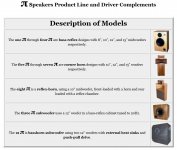
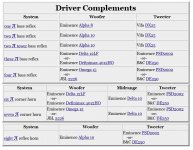
From:
Pi Speakers - Product Line and Driver Complements
You can get the plans for free (my kind of pricing!) by emailing him or posting on his forum:
AudioRoundTable.com: Pi Speakers
Or order well-priced kits:
Pi Speaker Kits
completed speakers:
Pi Speakers
and lots of other goodies like crossover PCBs, his newly designed H290C horn, flat-pack-easy-to-assemble mid horn (200Hz) kit ... :
Pi Parts and Options
Wait, there's more!
Links to some excellent info and software:
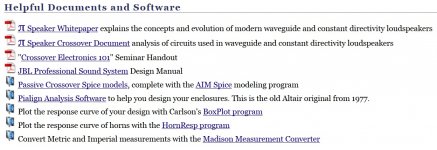
From the bottom of his Models and Drivers page:
http://www.pispeakers.com/Products.html
His own forum:
AudioRoundTable.com: Pi Speakers
And he recently did a lot of work to compile and organize his extraordinarily informative posts into an incredible FAQ
http://audioroundtable.com/forum/index.php?t=msg&th=17795&start=0&
Here are the topics:
General Information
High-Fidelity Uniform-Directivity Loudspeakers
Uniform Directivity - How important is it?
Notes for the DIYer
Pi horn design philosophies
My personal opinions of various design philosophies
Cornerhorns - a brief history
Constant Directivity Cornerhorn: Bass Bin Design Details
Corner pi speakers
Klipschorn vs seven π cornerhorn
Surround voicing and matching the mains
Models, Upgrades and Driver Characteristics
Info to compare Pi models
Options in a nutshell
Upgrades
Electro-mechanical properties and diaphragm motion
Magnet structures
Push-pull verses shorting rings
12pi push/pull benefits
Heat exchanger effectiveness
Speaker Voice Coil Cooling System Valve
Radiant Cooling System (Cooling Plug) Patent
Cabinet Design
Hoffman's Iron Law
Vented Speaker Systems
Response curves of closed vs. vented systems
Speaker damping - Overdamped, Underdamped or Critically Damped
Acoustic filter Q and PiAlign's "Qe"
Pi Alignments compared with B4, C4 and QB3
Helmholtz formula
Helmholtz frequency of each model
Displacement calculations (or measurements)
Cabinet design, port placement and internal standing waves
Golden ratio for loudspeaker cabinets
Trapezoid enclosures
Damping material placement
Altering dimensions
Horn / Waveguide information
12π Basshorn Subwoofer
Basshorn or Transmission Line
Midrange Horn
Midrange horn shape in Pi cornerhorn
H290C Horn/Waveguide
Horn phase
Pattern control and mouth size
Horn/Waveguide dimensions and beamwidth
Matching directivity in the vertical and the horizontal planes
Crossovers
Speaker motors and passive crossover filters
Crossover Electronics 101 Seminar Handout
Phase angles, crossovers and baffle spacing
Baffle spacing, phase angles and time alignment, revisited
Tweeter circuits for constant directivity horns and waveguides
Woofer size for uniform directivity loudspeakers
Crossover configuration
4Pi crossover study
Baffle Step
Room Effects and Loudspeaker Interactions
Constant directivity verses on-axis EQ for non-uniform directivity (aka baffle step filters)
Loudspeaker sensitivity and boundary loading
Boundary conditions and room interactions
Boundary conditions and floor bounce
Floor Bounce
In-wall Baffle
Imaging, placement and orientation
Speaker placement and wavefront launch
Corners and frequencies
Room modes, multisubs and flanking subs
Helper Woofer Location
Flanking Subs vs Helper Woofers
Simulations and Measurements
Speakers Measured Datasets
Spice crossover models
Determining mechanical reactance values for Spice models
Clarification of attenuation values
DI-matched two-way loudspeakers
Crossover optimization for DI-matched two-way speakers
Crossover optimization for DI-matched two-way speakers, revisited
The Acoustic Center: How it applies to Loudspeaker Measurements
Miscellaneous
Mounting Screws and T-Nuts
Gaskets
Midhorn Bracing
Finishing details for π cornerhorns
R11/R13 Fiberglass Insulation and Environmental Health
From:
AudioRoundTable.com: Pi Speakers => FAQ
And finally, Wayne's a fantastic guy. (Sorry to make you blush Wayne
The amount of info and help he provides through his forum and now here is mind-boggling (he still has a day job!). He's able to explain things at a newb and intro level (rarer than you might think!) but still possesses the experience and high-level technical knowledge to effectively debate with the likes of Earl Geddes (gedlee), Tom Danley, etc ...
Pi speakers Rock!
Cheers,
Jeff
PS No, I'm just a very satisfied and decade-old customer.
Last edited:
There isn't much you can add to that but...there is!
Wayne took the opportunity of the demise of the Eminence H290 horn to design and manufacture his own version but his is an OSEC waveguide/horn where the Eminence was exponential. Big improvement in clarity.
The new horn necessitates a change in the crossover attenuation cirscuit which includes adding a damping resistor across the horn. I found (must have been on a commission check payday) that Duelund CAST resistors in that position improved the clarity and neutrality even more. A lot more.
I've built several Pi Speakers, beginning with the Theatre 4s when I got the Bottlehead kit bug and later 2Pis, 2 Pi Towers (behind the 4Pis) and now my 4 Pis.
Wayne took the opportunity of the demise of the Eminence H290 horn to design and manufacture his own version but his is an OSEC waveguide/horn where the Eminence was exponential. Big improvement in clarity.
The new horn necessitates a change in the crossover attenuation cirscuit which includes adding a damping resistor across the horn. I found (must have been on a commission check payday) that Duelund CAST resistors in that position improved the clarity and neutrality even more. A lot more.
I've built several Pi Speakers, beginning with the Theatre 4s when I got the Bottlehead kit bug and later 2Pis, 2 Pi Towers (behind the 4Pis) and now my 4 Pis.
Attachments
- Status
- This old topic is closed. If you want to reopen this topic, contact a moderator using the "Report Post" button.
- Home
- Loudspeakers
- Multi-Way
- Sound quality of "PI" speakers?

